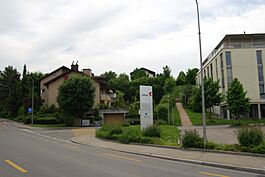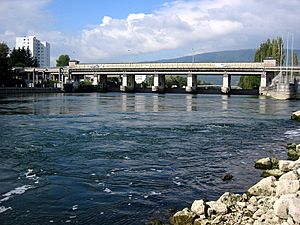Port, Switzerland facts for kids
Quick facts for kids
Port
|
||
|---|---|---|
 |
||
|
||
| Country | Switzerland | |
| Canton | Bern | |
| District | Biel/Bienne | |
| Area | ||
| • Total | 2.46 km2 (0.95 sq mi) | |
| Elevation | 448 m (1,470 ft) | |
| Population
(Dec 2020 )
|
||
| • Total | 3,801 | |
| • Density | 1,545/km2 (4,002/sq mi) | |
| Postal code |
2562
|
|
| Surrounded by | Aegerten, Bellmund, Biel/Bienne, Brügg, Ipsach, Jens, Nidau | |
Port is a small town, also called a municipality, located in the canton of Bern in Switzerland. It's part of the Biel/Bienne administrative district. Port is known for its interesting history and its location along an important canal.
Contents
Port's Ancient History: What We've Found
Port was first mentioned in official records way back in 1228. But people lived here much, much earlier!
Life by the River: From Stone Age to Iron Age
The banks of the Zihl/Thielle river have been home to people since at least the neolithic period, which was the New Stone Age. Scientists found remains of a Cortaillod culture village from around 4,000 BC. These early homes were stilt houses, built on poles above the ground.
Over thousands of years, different groups of people settled in the area. From the Bronze Age, which was a time when people used bronze tools, many cool items were found. These include swords, spearheads, axes, and sickles (tools for cutting crops).
Later, during the Iron Age, a Celtic settlement existed here. From this time, archaeologists discovered two helmets, metal containers, and about 120 swords and spearheads. Many of these swords were broken or bent on purpose. One bent iron sword even has an engraving in Greek letters with the name "Korisios." This is thought to be the oldest written document ever found in Switzerland! Wooden poles from the same time suggest that the settlement built a bridge over the river.
Even after the Celts, tools and weapons from the Roman era and the Early Middle Ages show that people continued to live in Port.
Becoming Part of Bern: A Town's Journey
By the 12th century, Port was owned by powerful families called the Counts of Neuchâtel. In the 13th century, it passed to the Counts of Neuchâtel-Nidau. When that family line ended, the region, including Port, was taken over by Fribourg in 1382.
However, Bern soon acquired the area in 1398, and Port has been part of Bern ever since.
Port's Modern Growth: A Suburb of Biel
The building of the Nidau-Büren Canal changed Port. It separated a part of the town called Portmoos from the rest. A suspension bridge was later built to connect them.
In the 1950s, Port started to grow as a suburb of the nearby city of Biel. Many people who live in Port now work in Biel or Nidau. As the population grew, new schools were built in Port in the 1950s and 1960s.
The Village Church: A Place of Worship Through Time
The village church in Port was first mentioned in 1228. It was a smaller church connected to the main church in Nidau. Later, in 1453, it became part of the church area of Bellmund.
When Bern adopted the Protestant Reformation in 1528, the church in Port was closed. Port then became part of the Reformed church area of Bürglen. About ten years later, in 1539, Port joined the Nidau church area. The original village church building was last mentioned in 1588.
A small chapel that was once an infirmary (a place for the sick) became a chapel with a cemetery in 1825-26. This chapel has been rebuilt and updated several times in the 20th century.
Port's Location and Landscape
Port covers an area of about 2.5 square kilometers (about 1 square mile).
How the Land is Used
- About 21% of Port's land is used for farming.
- Nearly 30% is covered by forests.
- Over 44% of the land is developed with buildings and roads.
- About 4% of the area is rivers or lakes.
Most of the forested land is covered with thick forests. For farming, about 14.6% is used for growing crops, and 4.9% is used for pastures where animals graze. A small part (1.6%) is used for orchards or vineyards. All the water in Port is flowing water, like rivers and canals.
The Nidau-Büren Channel: A Key Feature
Port is located on the Nidau-Büren channel. This channel connects Lake Biel with Solothurn. It was dug during a big project called the Jura water correction, which helped control water levels in the region. Because of the canal, the community is split into two parts.
The regulating dam Port, built in 1939, and a small footbridge, built in the 1980s, connect the two sides of the town. The municipality stretches from the channel up to the slopes of the Jensberg hill.
In 2010, Port joined a new administrative area called Verwaltungskreis Biel/Bienne.
Port's Coat of Arms
The blazon (description) of Port's municipal coat of arms is: Argent a Roman Helmet Sable. This means it shows a black Roman helmet on a silver (or white) background. This helmet is special because it's based on a real helmet found in 1890 in the Zihl/Thielle river.
Who Lives in Port?
Port has a population of about 3,243 people (as of December 2011).
Languages Spoken
Most people in Port speak German as their first language (about 84%). French is the second most common language (about 11%), and Italian is third (about 1.6%).
Population Makeup
- About 17.8% of the population are children and teenagers (0–19 years old).
- Adults (20–64 years old) make up 58.2%.
- Seniors (over 64 years old) make up 24.1%.
In 2000, about 18% of the people living in Port were born there. About 48% were born in the same canton (Bern), and about 21% were born elsewhere in Switzerland. Around 11% were born outside of Switzerland.
Homes and Families
In 2010, there were 453 households with only one person living in them. There were also 67 households with five or more people. In 2011, single-family homes made up about 72% of all the homes in Port.
Port's Economy: How People Work
Port has a low unemployment rate, which means most people who want to work can find jobs.
Jobs in Port
In 2008, there were 902 people working in Port.
- Primary Sector: 14 people worked in farming.
- Secondary Sector: 490 people worked in this sector, mostly in manufacturing (making things) and construction (building things).
- Tertiary Sector: 398 people worked in this sector, which includes jobs like sales, transportation, hotels, restaurants, and healthcare.
Even though many jobs are in Port, most people (about 83%) actually travel to nearby Biel and Nidau for work. This means Port is a "net exporter" of workers. About 17% of workers use public transportation to get to work, and 56% use a private car.
Religion in Port
Based on a 2000 survey:
- About 65% of people belonged to the Swiss Reformed Church (a Protestant church).
- About 17% were Roman Catholic.
- Smaller numbers of people belonged to other Christian churches, Islam, Buddhism, or Hinduism.
- About 10% of the population said they didn't belong to any church or were agnostic or atheist.
Education in Port
Education is important in Port. About 60% of the population has completed upper secondary education (like high school), and 22% have gone on to higher education at a university or a specialized college.
The School System
The Canton of Bern has a specific school system:
- One year of non-required Kindergarten.
- Six years of Primary school.
- Three years of required lower Secondary school, where students are grouped by their abilities.
- After lower Secondary, students can continue their education or start an apprenticeship (learning a trade on the job).
During the 2011-12 school year, 185 students attended classes in Port. There were 2 kindergarten classes with 37 students and 8 primary classes with 148 students. Some students in Port's schools were not Swiss citizens, and some had a different first language than the classroom language.
In 2000, most students (198) who lived in Port also went to school there. However, 187 residents of Port went to schools outside the municipality.
See also
 In Spanish: Port (Berna) para niños
In Spanish: Port (Berna) para niños







